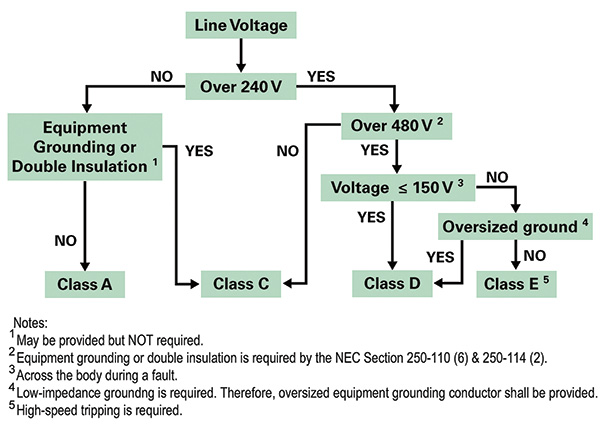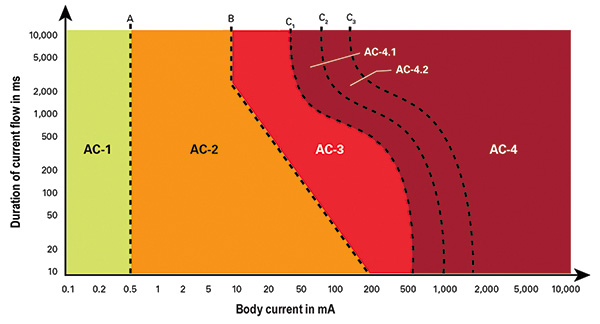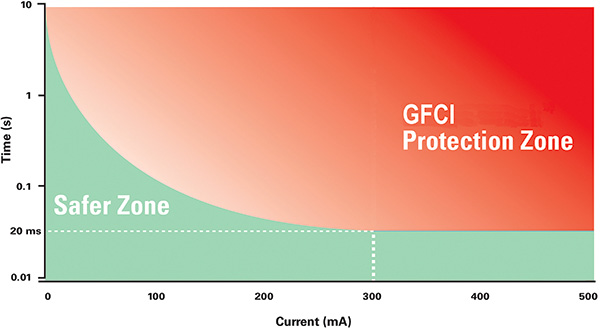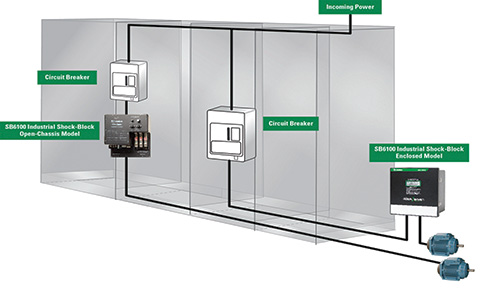Between 1992 and 2002, 3,378 on-the-job fatalities caused by electricity occurred—most from electrocution. From 1992 to 2010, electricity caused the deaths of three U.S. workers every four days.
If a pump has an electrical ground fault, water can bring the current into contact with a worker. The risk of shock is present anywhere that pumps are used, from municipal water plants and food processors to mines and amusement parks.
Clearly, safety measures should be implemented. It is interesting that a device proven to save lives, the ground fault circuit interrupter (GFCI), is not required in industrial settings, but it has been required in water-prone areas of homes—such as bathrooms, laundry rooms, kitchens and outside outlets—since 1973. Since their introduction into the electrical code, GFCIs have been credited with reducing residential electrocutions by 50 percent.
Fortunately, Underwriters Laboratories (UL) has extended the same protection to workers on the job that they have in their bathrooms by defining a standard for industrial GFCIs.
A GFCI’s Function
A GFCI (also called a residual current circuit breaker or RCCB) does one simple thing: it compares the current in hot (phase) and neutral (return) conductors of the circuit that it protects. For example, a three-phase unit compares the currents in all three hot phases. If these currents are equal, then nothing happens. However, if they differ by even a small amount, the current is leaking to ground somewhere—possibly through a person—and the GFCI quickly interrupts the power before that person can be injured.
Residential Versus Industrial GFCIs
Residential GFCIs (defined by UL 943 as Class A) found in bathrooms and kitchens are designed to trip at a leakage current of 6 milliamperes. This is fine in the home, but in an industrial setting, low-level ground leaks often present no danger but would cause a Class A GFCI to trip needlessly. On top of that, Class A GFCIs are intended only for circuits running at 240 volts or less, so they cannot be used on higher-voltage industrial equipment.
UL Standards for Industrial GFCIs
Reliable GFCIs suitable for industrial use did not exist until recently. Last year, UL published UL943C, Special Purpose Ground-Fault Circuit-Interrupters. It covers industrial GFCIs that operate on circuits up to 600 volts, will not trip until leakage current exceeds 20 milliamperes (comparable to the European standard of 30 milliamperes), and are suitable for industrial installations. GFCIs built to the new standard will increase reliability as well as protection.
UL943C separates industrial GFCIs into Classes C, D and E:
- Class A, under UL943, is for residential applications, with voltage of 120 or 240 in single-phase installations, with a 6-milliampere trip level (which is too low for industrial use).
- Class C is for use in circuits with no conductor more than 300 volts alternating current (AC) to ground where reliable equipment grounding or double insulation is provided.
- Class D is for use in circuits with one or more conductors more than 300 volts to ground and with oversized grounding to prevent the voltage across the body from exceeding 150 volts during a fault.
- Class E covers equipment similar to Class D but with high-speed tripping required. Therefore, the oversized ground of Class D is not required.
Figure 1 shows how to choose the class of GFCI for a particular application.
 Figure 1. How to choose the class of GFCI for a particular application
Figure 1. How to choose the class of GFCI for a particular applicationWhile UL 943C has been released, the National Electrical Code (NEC) does not yet require the use of industrial GFCIs. It does, however, require the use of GFCIs for specific applications. As awareness of the new UL standard increases, acceptance will also increase, and some industry players expect the NEC to be updated to require GFCIs in more applications.
Time Response of a GFCI
The time taken for a GFCI to trip depends on the level of leakage current. Figure 2 shows the effects of current on the body: currents in zone AC-1 are generally imperceptible, and currents in zone AC-2 up to curve B are perceptible but not harmful unless they continue for too long. Similarly, the higher zones show increasing danger, but danger correlates with time—the longer the current continues, the greater the danger is.
 Figure 2. The effects of current on the body: currents in zone AC-1 are generally imperceptible; currents in zone AC-2 up to curve B are perceptible but not harmful unless they continue too long. Similarly, the higher zones show increasing danger, but danger correlates with time—the longer the current continues the higher the danger risk.
Figure 2. The effects of current on the body: currents in zone AC-1 are generally imperceptible; currents in zone AC-2 up to curve B are perceptible but not harmful unless they continue too long. Similarly, the higher zones show increasing danger, but danger correlates with time—the longer the current continues the higher the danger risk.All GFCIs follow a trip curve defined by UL943 and shown in Figure 3. At 300 milliamperes, the GFCI must trip within 20 milliseconds, while smaller currents take longer. A current of 20 milliamperes corresponds to a trip time of about one second.
 Figure 3. All GFCIs follow a trip curve defined by UL943. At 300 milliamperes, the unit must trip within 20 milliseconds, while smaller currents take longer. A current of 20 milliamperes corresponds to a trip time of about one second.
Figure 3. All GFCIs follow a trip curve defined by UL943. At 300 milliamperes, the unit must trip within 20 milliseconds, while smaller currents take longer. A current of 20 milliamperes corresponds to a trip time of about one second.Alternatives to Industrial GFCIs
For higher leakage currents up to 50 milliamperes, equipment ground-fault protection devices (EGFPDs) can be used. EGFPDs fall under a different UL standard and are intended for equipment and not personnel protection. In reality, EGFPDs also provide some personnel protection when the industrial GFCIs cannot be used.
Another device may be confused with a GFCI but is different and is used for different purposes. This is the ground fault relay (GFR—also called a ground fault monitor). GFRs are intended purely to protect equipment, not people.
A GFR does not open the circuit directly but triggers an upstream circuit breaker to open. While the GFR may react in about a millisecond, the circuit breaker takes much longer to open—enough time for an electrical shock to stop someone’s heart. In addition, the trip level of a GFR can be set anywhere from up to 3 amperes (a fatal level of current), and its time delay can be set to as much as one second. Clearly, this is not intended for personnel protection. While GFRs are not intended to protect people, they do so indirectly by minimizing electrical hazards and damage to equipment. Ninety percent of ground faults occur slowly because of insulation breakdown, and a GFR can identify such an incipient ground fault before it escalates into a full-blown short to ground.
In contrast to GFRs, GFCIs are intended to protect people. They are used on grounded systems and can be set to trip at ground current levels as low as 6 milliamperes for Class A and 20 milliamperes for Classes C, D, and E. A GFCI contains its own contactor to interrupt power much more quickly than a GFR.
How Industrial GFCIs Are Installed
Installing an industrial GFCI is relatively simple. They are much larger than their residential cousins and are mounted inside an existing electrical cabinet or other piece of equipment. They may also be ordered with their own enclosures and mounted like an electrical panel (see Figure 4). For temporary applications, the industrial GFCI may be located on a wheeled cart to make it easy to move to temporary locations.
 Figure 4. Installation diagram for industrial GFCIs
Figure 4. Installation diagram for industrial GFCIsWhere Industrial GFCIs Are Used
Industrial GFCIs may be used anywhere, but they are especially valuable in situations with a combination of high voltage, contact with people and a presence of water or process fluids. This can include submersible pumps, wash-down areas, aerators, high-pressure washers and mixers.
Other candidate areas include pumps used for construction/temporary equipment and maintenance activities in which workers may need to enter tanks for cleaning, and dewatering pumps may be used when cleaning tanks.
GFCIs are useful with pumps in services that require frequent contact with operators or people, such as in paint booths, fountains, pools, water parks and amusement parks.
Although the first place to apply GFCI protection is in high-voltage equipment, such as a 480- or 600-volt pump, the amount of ground fault current that can kill a person is small. Therefore, an industrial GFCI is appropriate for lower voltage pumps if it is located in equipment that sees frequent maintenance or frequent operator contact.
Summary
The danger of electric shock is present wherever people and electricity come together. The risk is higher in equipment that contains pumps because if there is anything more dangerous than electricity and people, it is electricity and people plus water.
Considering how many people are killed or injured by electric shock in industrial facilities each year, there has long been a need for better of protection. At the same time, Occupational Safety & Health Administration has been increasing fines for injuries to electrical workers, and the cost of medical bills and liability continue to rise. Moreover, a death or injury will be tragic and cause downtime that may be very expensive. Now that industrial GFCIs have finally become available, it would be wise for managers to consider their use.


